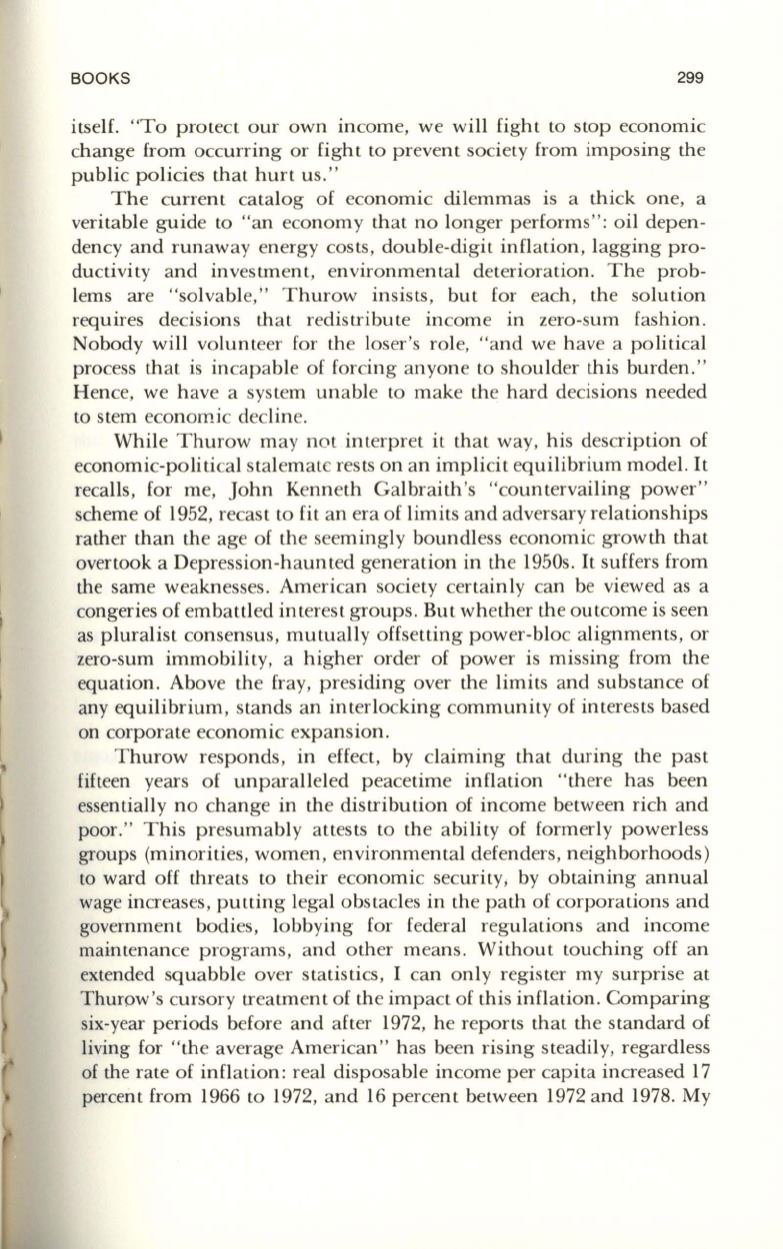
BOOKS
299
itself. "To protect our own income, we will fight
to
stop economic
change from occurring or fight
to
prevent society from imposing the
public policies that hurt us."
The current catalog of economic dilemmas is a thick one, a
veritable guide to "an economy that no longer performs " : oil depen–
dency and runaway energy costs, double-digit inflation, lagging pro–
ductivity and investment, environmental deterioration. The prob–
lems are "solvable," Thurow insists, but for each, the solution
requires decisions that redistribute income in zero-sum fashion.
Nobody will volunteer for the loser's role, "and we have a political
process that is incapable of forcing anyone to shoulder this burden."
Hence, we have a system unable to make the hard decisions needed
to
stem economic decline.
While Thurow may not interpret it that way, his description of
economic-political stalemate rests on an implicit equilibrium model.
It
recalls, for me, John Kenneth Galbraith's "countervailing power"
scheme of 1952, recast
to
fit an era of limits and adversary relationships
rather than the age of the seemingly boundless economic growth that
overtook a Depression-haunted generation in the 1950s. It suffers from
the same weaknesses. American society certainly can be viewed as a
congeries of embattled interest groups. But whether the outcome is seen
as pluralist consensus, mutually offsetting power-bloc alignments, or
zero-sum immobility, a higher order of power is missing from the
equation. Above the fray, presiding over the limits and substance of
any equilibrium, stands an interlocking community of interests based
on corporate economic expansion.
Thurow responds, in effect, by claiming that during the past
fifteen years of unparalleled peacetime inflation "there has been
essentially no change in the distribution of income between rich and
poor." This presumably attests to the ability of formerly powerless
groups (minorities, women , environmental defenders, neighborhoods)
to
ward off threats
to
their economic security, by obtaining annual
wage increases, putting legal obstacles in the path of corporations and
government bodies, lobbying for federal regulations and income
maintenance programs, and other means. Without touching off an
extended squabble over statistics, I can only register my surprise at
Thurow's cursory treatment of the impact of this inflation. Comparing
six-year periods before and after 1972, he reports that the standard of
living for "the average American" has been rising steadily, regardless
of the rate of inflation: real disposable income per capita increased 17
percent from 1966
to
1972, and 16 percent between 1972 and 1978. My


